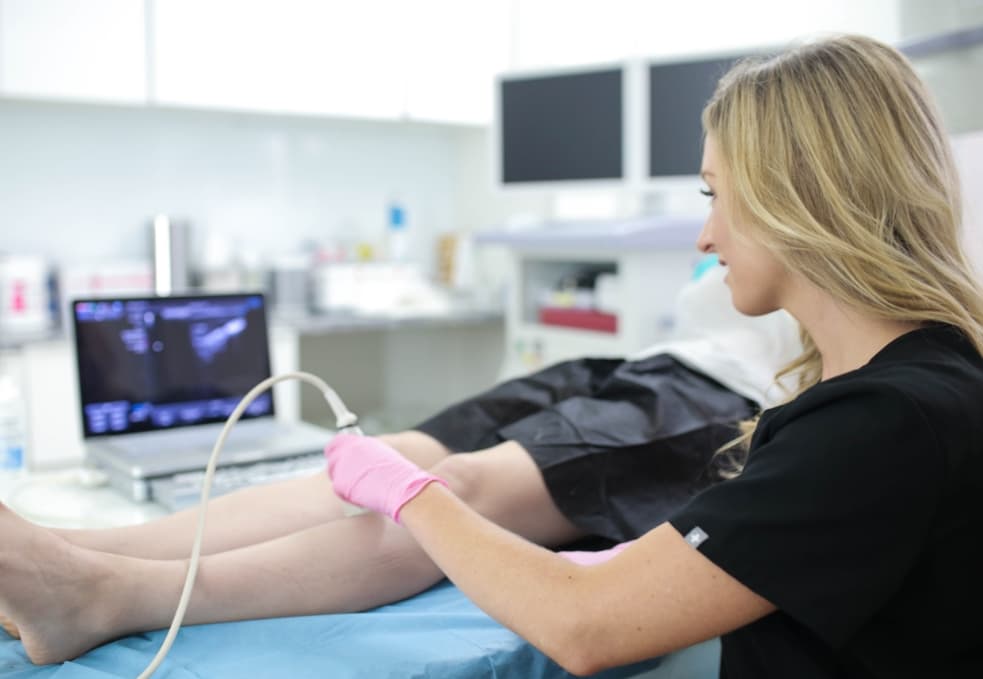Can venous insufficiency Be cured?
If you’re wondering if chronic venous insufficiency can be cured, you might have received the diagnosis of vein disease. Or perhaps you have the signs or symptoms of vein disease. Or maybe you’re simply curious. Either way, the simple answer is no: venous insufficiency can’t be cured. But it CAN be treated with minimally invasive procedures.
What’s the difference between curing chronic venous insufficiency vs. treating chronic venous insufficiency? To understand why venous insufficiency can be treated but not cured, you need to understand what chronic venous insufficiency is, how it happens, and what it indicates. And if you have the signs and symptoms of vein disease, you also need to consult a vein doctor.
Maryland Vein Center is a state-of-the-art vein center specializing in cutting-edge minimally invasive procedures for chronic venous insufficiency and varicose veins. Our board-certified vein doctors curate personalized treatment plans to address the root cause of varicose veins and your vascular conditions, ensuring safe, consistent, and long-lasting results.
Our vein center is located at 10215 Fernwood Rd, Suite 301, Bethesda, Maryland. If you’re in the Beltway, you can find our vein center in Maryland just outside of Washington, DC, in Silver Spring. We provide free insurance verification with your initial consultation. If you have the signs and symptoms of vein disease, please schedule an appointment online.
Having said that, please continue reading for a thorough exploration of chronic venous insufficiency, its symptoms, and the treatment options.

What is chronic venous insufficiency?
Chronic venous insufficiency is a dangerous circulatory disorder caused by the collapse of vein valves. Healthy veins have valves that act as one-way doors that ensure smooth blood circulation to the heart, often against the force of gravity, such as from the legs to the heart. When your vein valves collapse or malfunction, blood flows backward due to gravity, eventually leading to the accumulation of blood in leg veins.
Venous insufficiency is the primary root cause of spider veins and varicose veins on the legs
Chronic venous insufficiency is the primary root cause of most vascular conditions, including spider veins and varicose veins. The continued accumulation of blood in leg veins leads to vascular dilation. As more blood pools in the leg veins, your veins dilate, expand, and appear in dense clusters of blood vessels on your skin’s surface (spider veins). Over time, the dilated veins may bulge out of the skin’s surface, leading to protruding varicose veins.
Signs and symptoms of vein disease:
- Leg heaviness
- Leg pain
- Leg swelling
- Leg cramps
- Restless leg syndrome
- Spider veins
- Varicose veins
- Skin discoloration
- Leg ulcers
Do men get varicose veins?
Spider veins and varicose veins are the most visible symptoms of chronic venous insufficiency. There’s a pervasive myth that spider veins and varicose veins only affect women, but that’s simply not true. Varicose veins can affect men of all ages. Women are more likely to get varicose veins because a higher concentration of estrogen and progesterone is linked to a higher incidence of vein valve collapse. But men can also get varicose veins.
In fact, the risk of varicose veins is particularly high amongst men with a family history of vein problems, a medical history of deep vein thrombosis, or those over the age of 50. As men get older, their vein valves weaken because of general wear and tear, leading to a higher risk of vein disease. Furthermore, if your mom and dad have a history of vein problems, there’s a 90% chance that you will also have vein problems, even if you’re male.
Vein disease can’t be cured… but it can be treated
Now that you have a better understanding of chronic venous insufficiency, let’s address your primary concern: can venous insufficiency be cured? The simple answer is no: venous insufficiency can’t be cured. But it CAN be treated.
Chronic venous insufficiency occurs when your vein valves malfunction or collapse, leading to backward blood flow and the accumulation of blood in leg veins. Curing chronic venous insufficiency would indicate that the damaged vein valve is healed or fixed, thus reversing the effects of vein disease. But that’s simply not possible. There are no lifestyle changes, home remedies, minimally invasive treatments, or surgical procedures capable of fixing the damaged vein valve, so the disease is incurable.
BUT chronic venous insufficiency is very easily treated. Our vein doctors use cutting-edge, minimally invasive procedures to ablate (burn) or seal the diseased saphenous vein’s walls. Once the diseased vein is closed off, the accumulated blood reroutes into healthier leg veins, restoring optimal blood circulation to the heart. The diseased saphenous vein eventually hardens into scar tissues that are absorbed by the body. As such, minimally invasive vein treatments eliminate the diseased vein to restore optimal blood flow to the heart.
The best minimally invasive procedures for chronic venous insufficiency:
- Endovenous laser ablation
- Endovenous radiofrequency ablation
- VenaSeal
- ClariVein (mechanochemical ablation)
- Foam sclerotherapy
What is the best treatment for varicose veins in the legs?
The best way to treat varicose veins in the legs is through minimally invasive procedures. The vein doctor will start your treatment with endovenous ablation, VenaSeal, or other procedures that address the root cause of varicose veins (chronic venous insufficiency). The vein doctor will use thermal energy, laser energy, or medical adhesives to collapse or seal the diseased saphenous vein responsible for your vein problems, so the diseased vein will harden and get absorbed by the body.
After treating vein disease, the vein doctor may administer an ambulatory phlebectomy for the superficial varicose veins. Ambulatory phlebectomy is a minimally invasive procedure that involves the physical extraction of superficial varicose veins through small incisions on the skin’s surface. Once the superficial varicose veins are removed, the incision marks will gradually heal and fade away from the skin’s surface. The procedure concludes within an hour and doesn’t involve any downtime.




